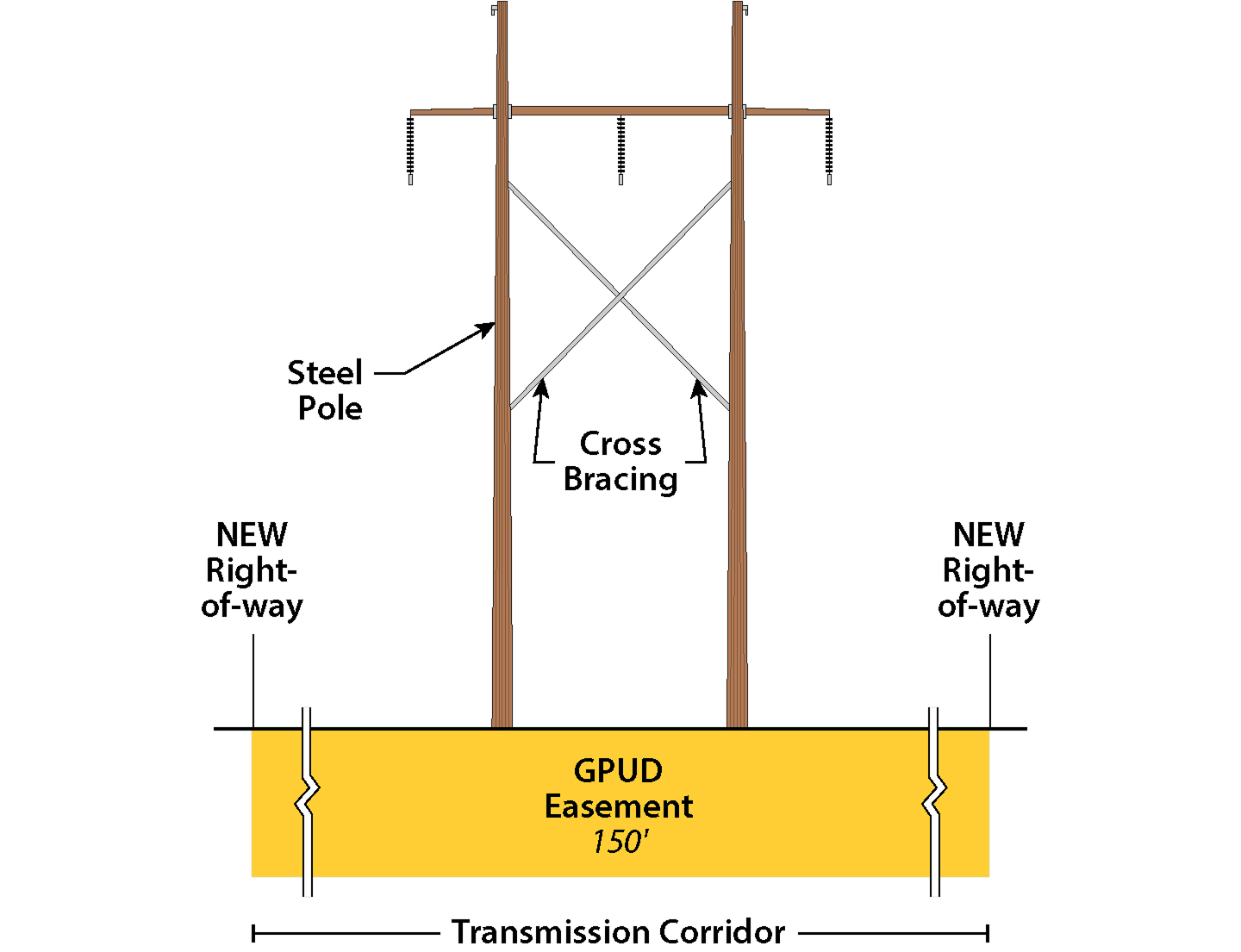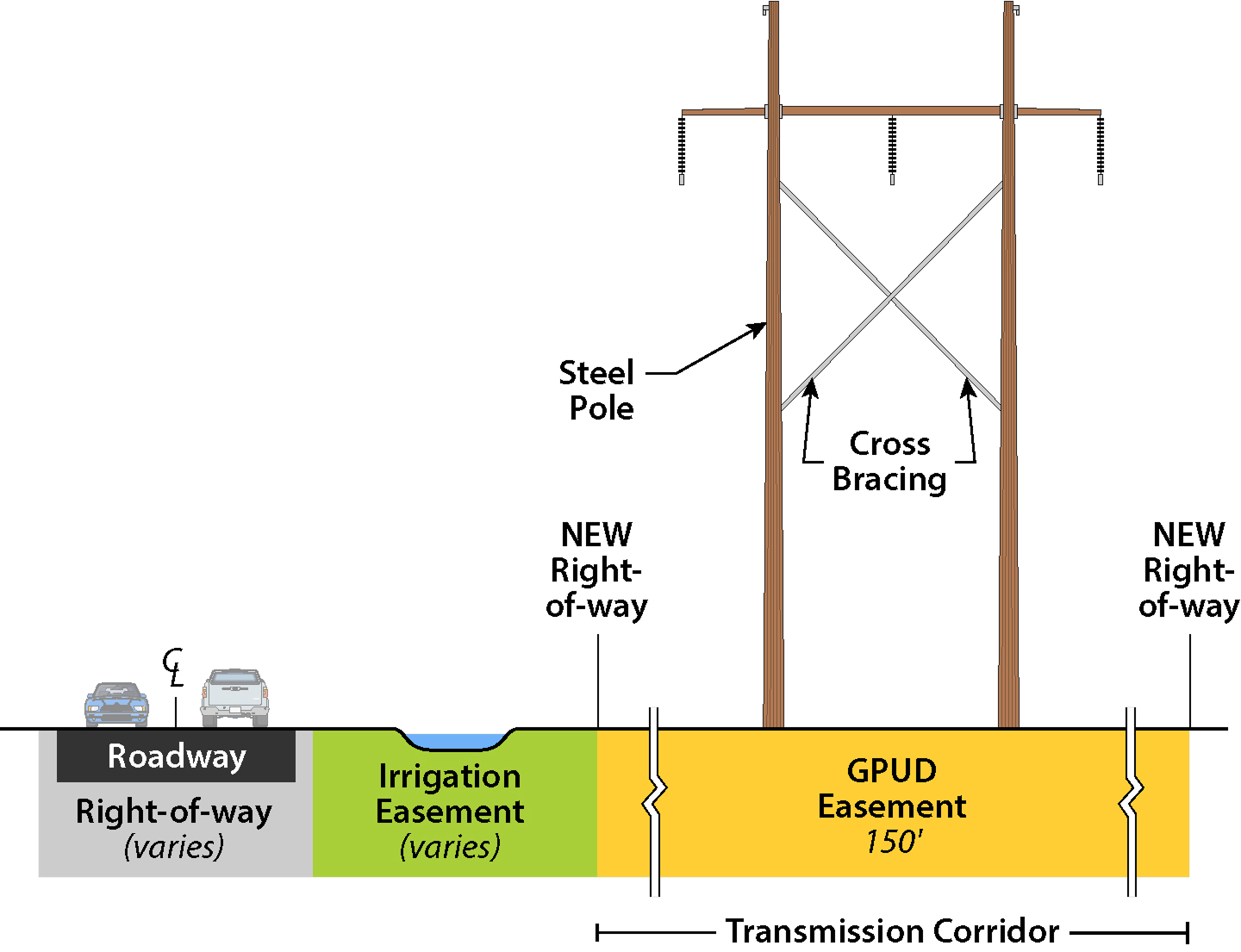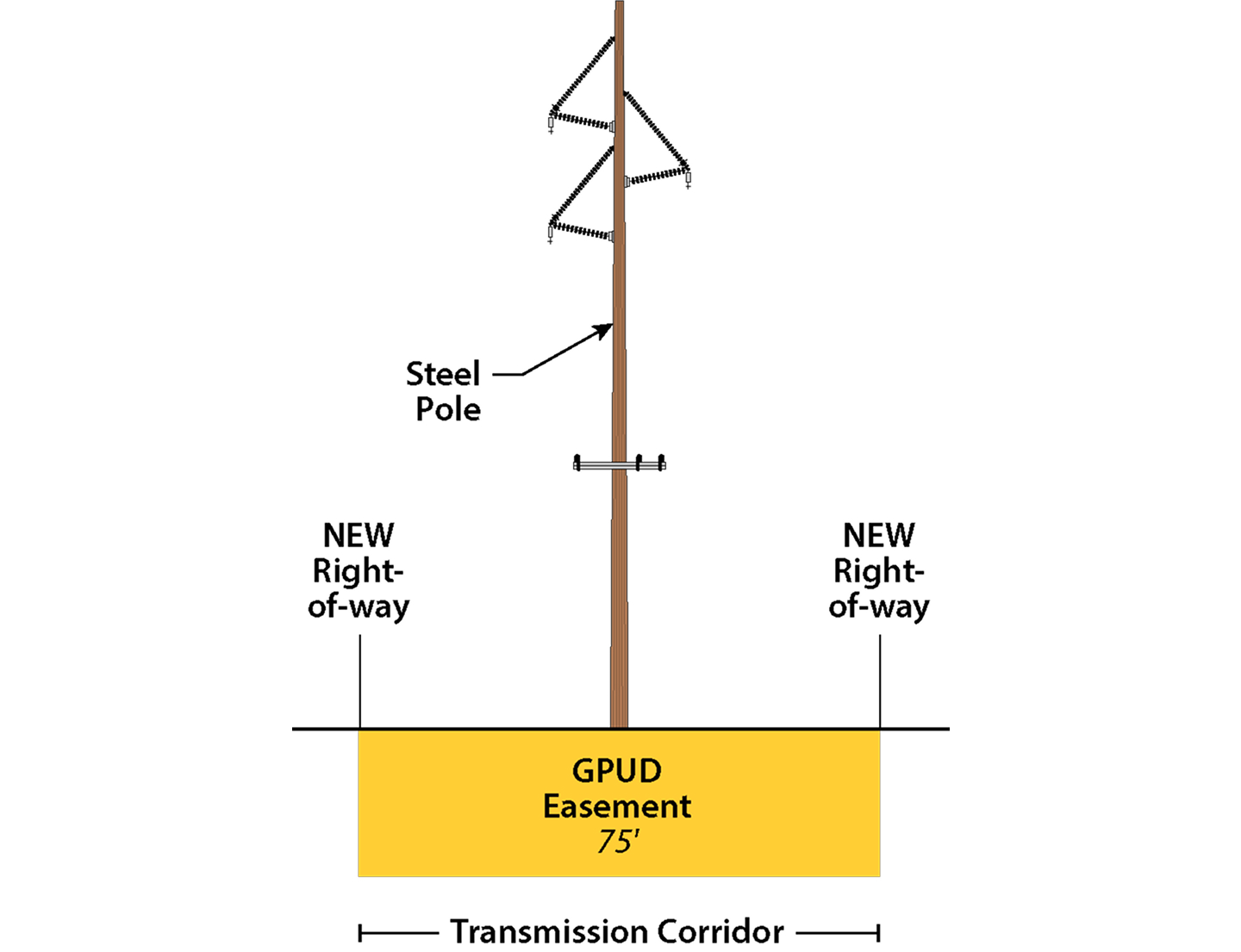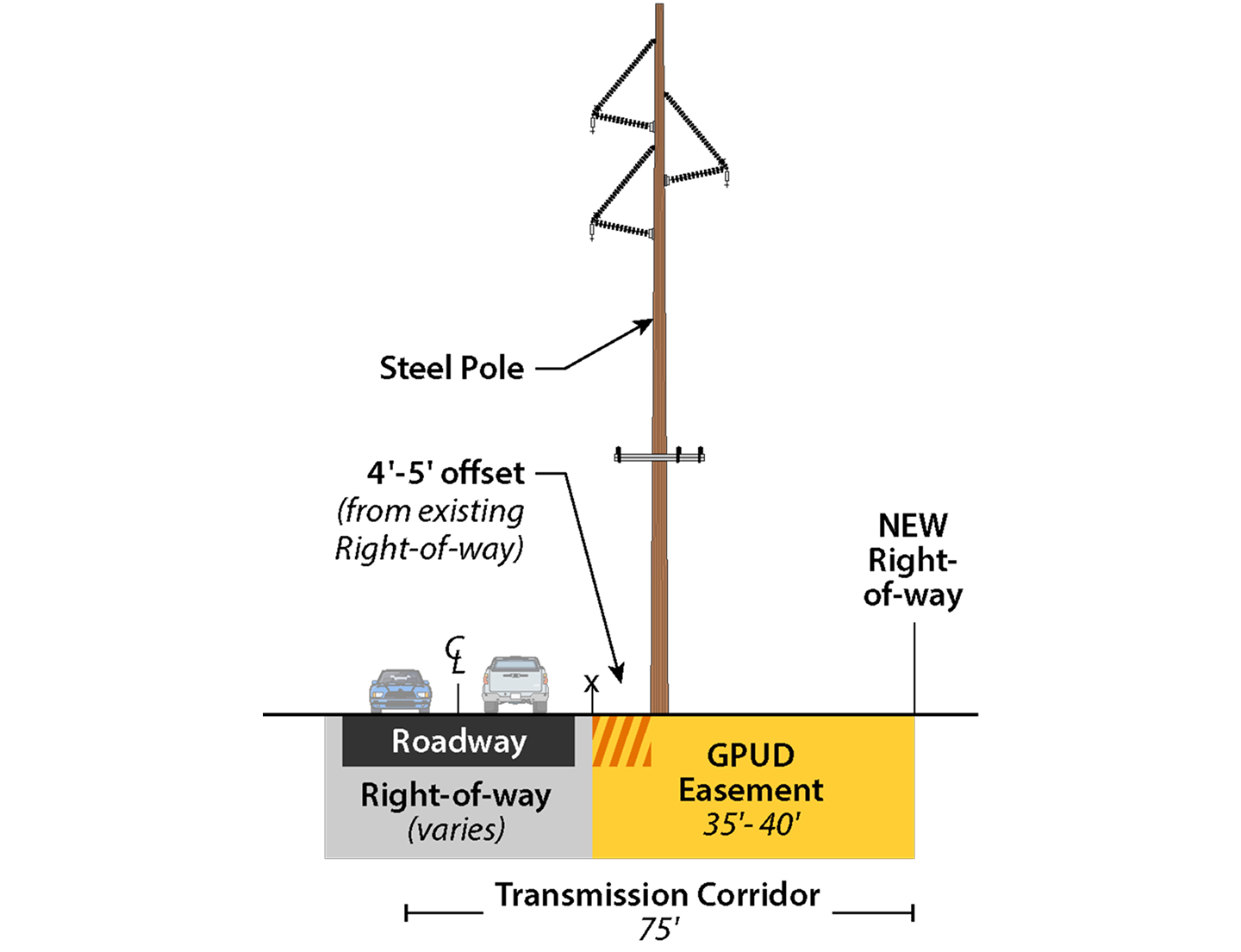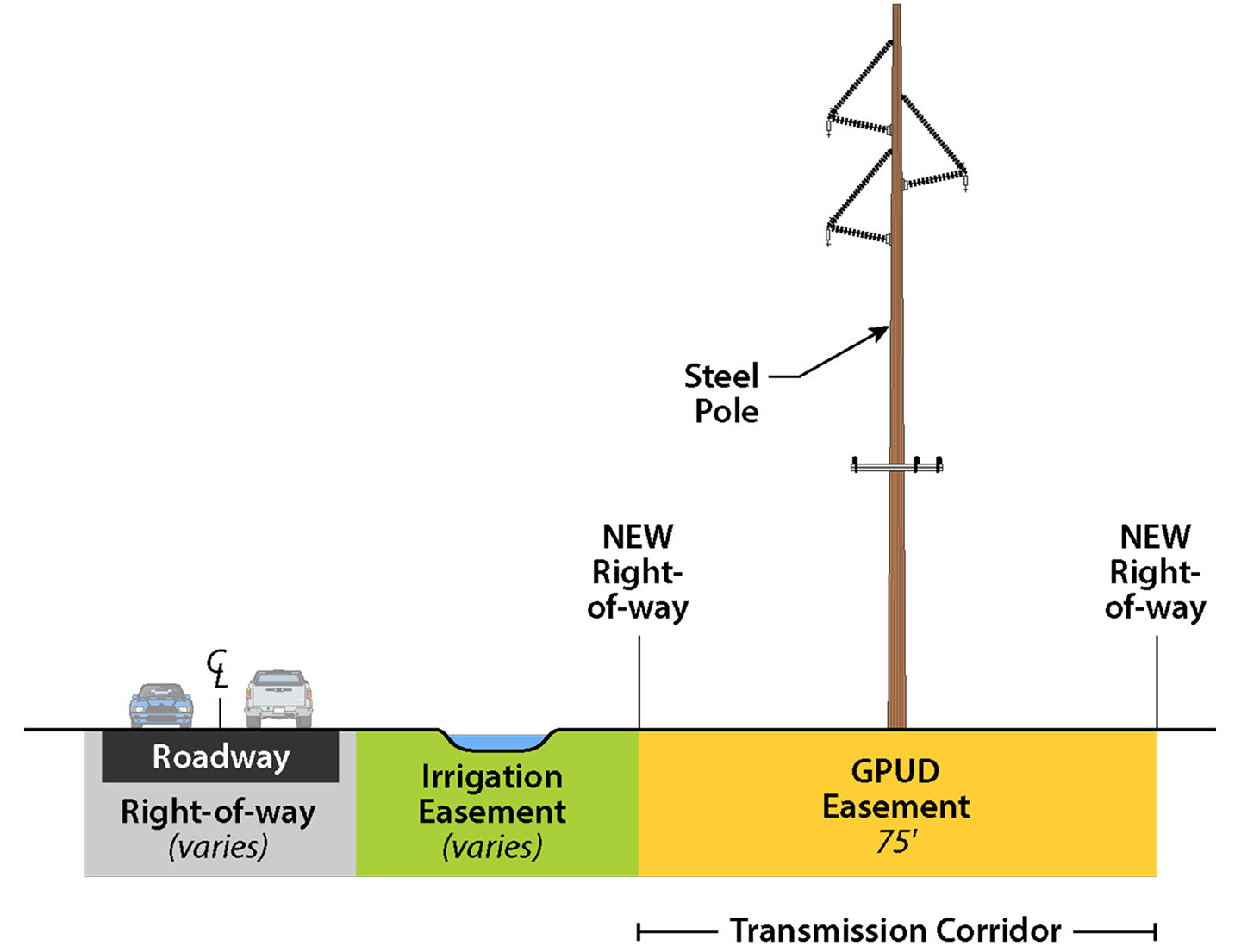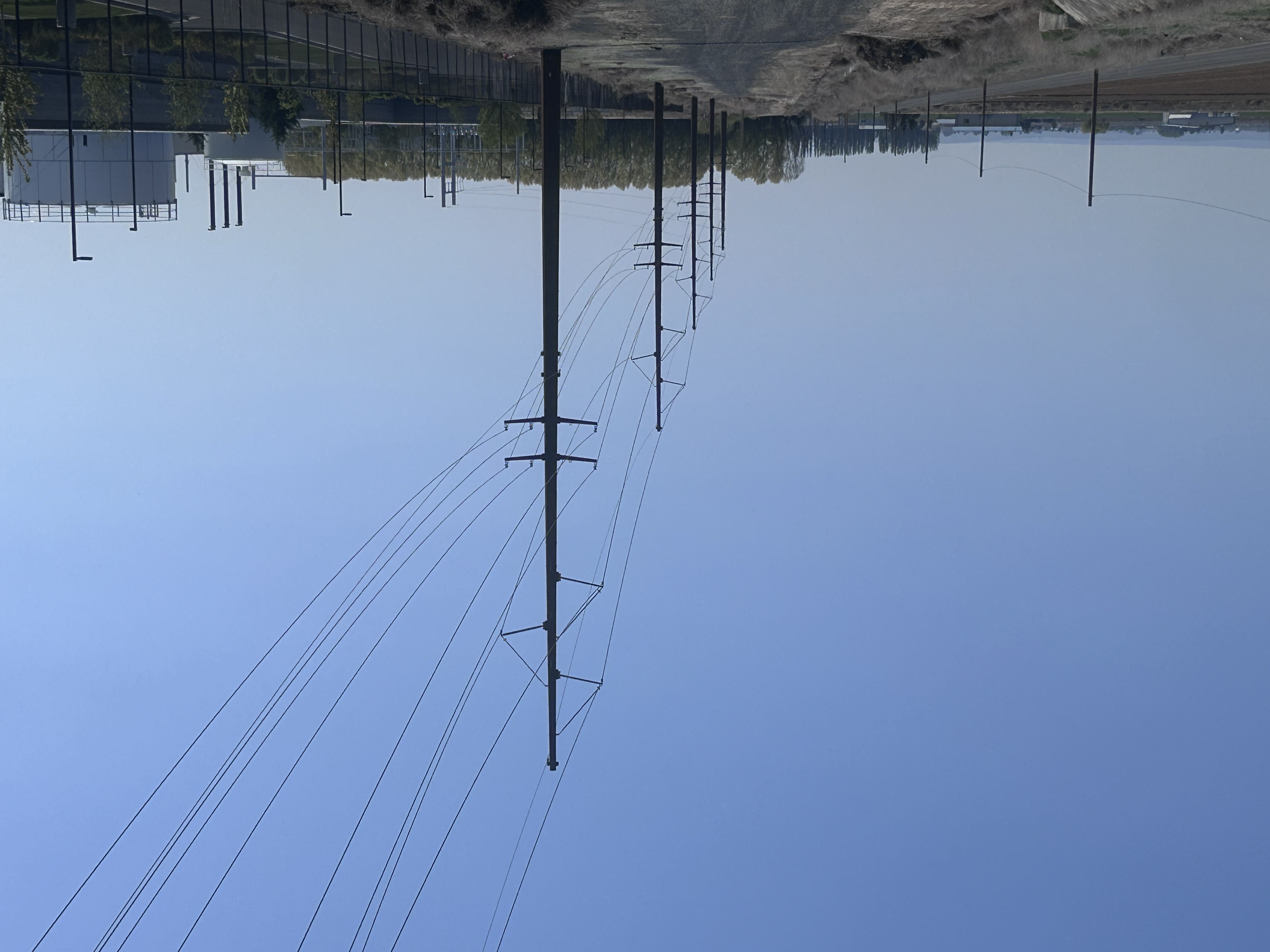Landowner Resources
Serving our customers requires teamwork. We acquire easements to build, maintain, and operate transmission lines while allowing you to continue owning and using the land. Together, we can serve future generations with reliable electricity.
Right-of-Way 101
Grant PUD pays landowners to acquire rights-of-way (ROW) to build, maintain, and operate transmission lines. Landowners retain ownership of the land, but they give Grant PUD permission to use the land indefinitely (even if they sell the property).
Easements & Structures
In most cases, Grant PUD will seek to acquire a small corridor of land, just enough to place poles on the property and for the wires attached to the poles. Easement widths vary due to engineering, structural, environmental, and technical considerations. The diagrams below depict various easement and property arrangements for the QTEP projects.
Click or tap on the images to enlarge.
H-Frame Structures
Single Pole Structures
Pole Placement Along Roadways
For some projects, we align the transmission line along existing roadways. The graphic below depicts the arrangement of transmission and distribution poles.
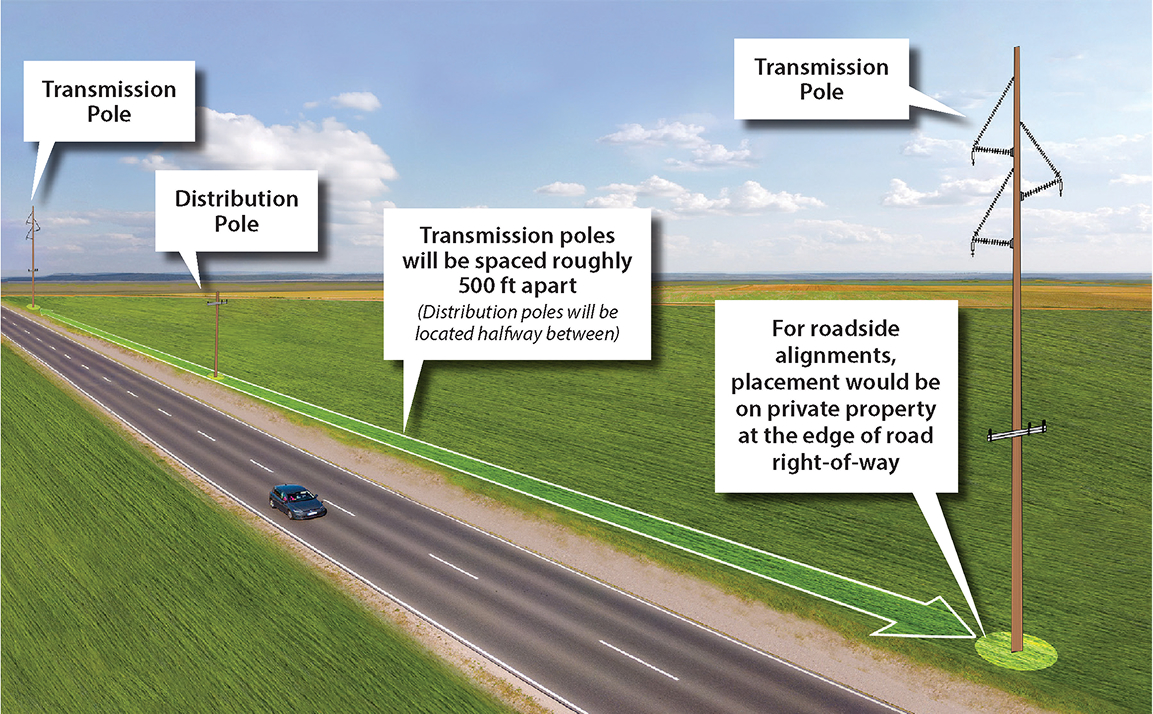
Land Use in the ROW
Land within the right-of-way easement may still be used in ways that do not interfere with the operation, maintenance, or construction of the line.
Typically Allowable
Provided that the use does not interfere with the construction, operation, and maintenance of the transmission line.
- Farming/mowing
- Gardens with vegetation less than 30 feet tall
- Trees less than 30 feet tall and not within 20 feet of a structure
Not Allowable
We encourage landowners to work with their Grant PUD Land Specialist to discuss specific land use activities.
- Buildings and structures (homes, barns, sheds, etc.)
- Fences
- Playgrounds and other structures
- Tall trees and vegetation, berms, etc.
Land Acquisition Process
Acquiring the appropriate right-of-way easements is a multi-step process. We work with landowners every step of the way.
Swipe or scroll to view each step.
-
Connecting with Individual Landowners
Grant PUD begins discussions with individual landowners by phone or in person about obtaining Right of Entry onto their lands to conduct the necessary surveys and studies, as well the process of purchasing right-of-way. -
Land Surveys and Studies
Surveyors, technical staff and engineers visit each property to identify potential pole locations and determine ground conditions. -
Appraisals
With the assistance of independent appraisers, appraisals are completed to determine the fair market value of the property that Grant PUD wants to acquire easement rights to. -
Compensation Offer for Easement Rights
With the assistance of independent appraisers, appraisals are completed to determine the fair market value of the property that Grant PUD wants to acquire easement rights to. -
Final Agreement
Grant PUD and the landowner reach final agreement for the right-of-way. Property owners may hire a professional appraiser to evaluate Grant PUD's offer. -
If an agreement can't be reached...
As a last resort, Grant PUD may pursue a process called condemnation (or eminent domain) if an agreement cannot be reached with a landowner. Condemnation is a rarely used government process under which a judge can decide whether the right-of-way is needed and its value.
Landowner FAQs
View some of the most frequently asked questions about easements, right-of-way, and land use. For a full list of FAQs, visit our FAQs page.
Steel poles will be used, and they will have a natural rust-colored finish. There will be both transmission and distribution poles and lines along the corridor. The transmission poles and lines will be about 100 feet tall, and the distribution poles and lines will be about 40 to 65 feet tall. All but a very small area around the poles can be utilized for existing uses. Irrigation canals require pole placement about 40 feet away from canals to allow access for canal maintenance. View the Structures section above to learn more.
Grant PUD has yet to propose the locations of the poles. During subsequent planning phases, Grant PUD will develop conceptual designs that will provide information such as proposed angle locations and the side of the road on which the lines could potentially be located for the selected routes. The subsequent phases of the design process will determine the requirements for new or expansion of existing easements.
Grant PUD will negotiate directly with private property owners to acquire the necessary easements and rights-of-way. Experience shows that fair and reasonable agreements are reached after an appraisal process that takes into account the features of each particular property. It is in Grant PUD's interest to make every effort to reach agreements quickly and fairly.
Right-of-way acquisition gives permanent easement rights to Grant PUD to use the land or property to build and maintain the transmission line. Landowners are paid for the use of the land and retain ownership of the land, but they give Grant PUD permission to use the land indefinitely. If the property is sold, the new owner is bound to the terms of the easement. In most cases, Grant PUD will seek to acquire a small corridor of land, just enough to place poles on the property and for the wires attached to the poles. In addition to still owning the land, landowners can use the land except for a small area around the poles. There are some limitations to what can be placed under the lines that will run between the poles. For example, buildings or trees would not be allowed.
Right-of-way acquisition is a multi-step process that includes the following steps:
- Connecting with Individual Landowners: Grant PUD begins discussions with individual landowners by phone or in person about obtaining Right of Entry onto their lands to conduct the necessary surveys and studies, as well the process of purchasing right-of-way.
- Land Surveys and Studies: Surveyors, technical staff and engineers visit each property to identify potential pole locations and determine ground conditions.
- Appraisals: From there, with the assistance of independent appraisers, appraisals are completed to determine the fair market value of the property that Grant PUD wants to acquire easement rights to.
- Compensation Offer for Easement Rights: Grant PUD makes an offer based on appraisals by independent appraisers of like properties to establish fair market value of the easement area. Offers are typically 25- 40% of the appraised fair market value.
- Negotiating Final Agreement: Grant PUD and the landowner negotiate a final agreement for the right-of-way. Property owners may hire a professional agent to evaluate Grant PUD's offer.
As a last resort, Grant PUD may pursue a process called condemnation if an agreement cannot be reached with a landowner. Condemnation is a rarely used process under which a judge can decide whether the right-of-way is needed and its value. Condemnation is part of a government's right to acquire or authorize the acquisition of a private property for public use with just compensation to the owner. This is also referred to as eminent domain.
Except for emergency situations, property owners can generally expect the line to be accessed once a year by Grant PUD. Maintenance will be conducted if issues are observed during the assessment. Maintenance may include pruning trees that encroach in the right-of-way. In the event of an outage the line could be accessed as line crews troubleshoot the root cause of the outage.
Yes! Land within the easement may be used in ways that do not interfere with the operation, maintenance, or construction of the line. We intend to minimize impacts to agricultural operations during the design, construction, operations and maintenance of the transmission line. Since agriculture operations vary along the route of this project, we plan to work through specific land use and operational concerns with each individual property owner.
Land within the right-of-way easement may still be used in ways that do not interfere with the operation, maintenance, or construction of the line.
The effect of a transmission line project on property values can be significantly reduced or eliminated by setback distance, intervening landscaping, shielding of visual effects, and integration of the transmission line corridor into the neighborhood (trails, for example). Recent studies analyzing the effect of transmission lines on property values have concluded that transmission lines alone typically do not have a significant negative impact on property values.
GPS signal interference should not generally occur as a result of transmission lines. GPS devices continuously pull signals from multiple satellites—not just one. If farming equipment has a GPS unit, the equipment should work as properly when underneath a transmission line as it does when not near a transmission line. There is potential for a signal to be temporarily blocked, although the signal should come back within a few seconds as the farm equipment continues to move.
The Institute of Electronics Engineers (IEEE) previously published a white paper titled “Use of Global Positioning System (GPS) Receivers Under Power-Line Conductors,” which evaluated a similar question. The potential effects of electromagnetic interference and/or signal scattering from overhead conductors are evaluated analytically and with some practical measurements under transmission lines. Based on the analysis presented in the IEEE white paper, it is unlikely that power line conductors will interfere with use of the GPS satellite signals.

